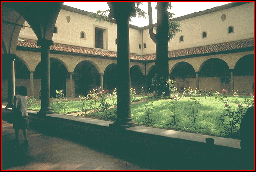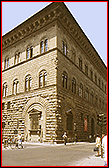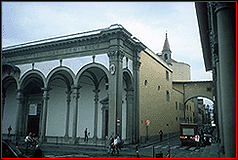Michelozzo
1396-1472
BACKGROUND
Name
Michelozzo di Bartolommeo is also referred to as Michelozzo Michelozzi, a name that was wrongly used in reference to him in the sixteenth century. Because Vasari drew on this erroneous source for his Lives, the name error became widespread.
Origin
Michelozzo was the son of a tailor who was originally from France.
Early Career in Sculpture
Michelozzo's early training is not known, but his early work in metal suggests that he had been apprenticed to a sculptor.
In 1410, Michelozzo began working as an engraver for the mint of Florence, and in 1435, he became its head.
In 1420 Michelozzo became a master in the Stonemasons' and Carpenters' guild.
Collaboration with Ghiberti
Michelozzo collaborated with Ghiberti on a commission from the Money changers' guild for casting a statue of St. Matthew for one of the tabernacles on the exterior of Orsanmichele.
Collaboration with Donatello
In the mid-1420s, Michelozzo established a partnership with Donatello, and they collaborated on numerous projects in Florence and other cities.
Their work included tomb monuments, ecclesiastic furnishings such as baptismal fonts, pulpits, and sculpture for the exteriors of buildings. The exterior pulpit for Prato Cathedral exemplifies their work.
ARCHITECTURAL CAREER
Early Architectural Work
In the 1430s, Michelozzo's attention was increasingly focused on architecture. He and other artists worked on a dike project for the city of Florence in 1430, and he worked as a military engineer for Montepulciano in 1432.
Style
Michelozzo's style owes much to Brunelleschi. He used a classical vocabulary and sharply contrasting materials such as pietra serena and plaster, which produced a clarity much like that seen in the works of Brunelleschi. Michelozzo's trim, however, was often more ornate and higher in relief than Brunelleschi's.
Michelozzo was innovative through his use of fluted freestanding columns. (Brunelleschi had only used fluting on pilasters.)
Despite their classicism, Michelozzo's buildings generally retained certain Gothic elements.
Patronage
Michelozzo's career was closely tied to the Medici family. He was the favorite architect of Cosimo de' Medici, who he accompanied to Venice after the Medici family's exile from Florence. In 1434, Cosimo's party in the Florentine government regained power, and the Medici returned to Florence.
Michelozzo later worked for Cosimo's son, Piero the Gouty, who succeeded his father in 1464.
Other important patrons include the Giustiniani family of Venice, for whom he traveled to the Greek island of Chios in the 1460s.
Importance and Influence
Michelozzo was the most important architect in Florence after Brunelleschi's death, a fact recognized by his appointment to complete the lantern of Florence Cathedral, which Brunelleschi designed and began.
Although the attributions are doubted today, the designs of two buildings in Milan have been attributed to Michelozzi because of both their styling and their having been commissioned by Medici agent Pigello Portinari in the 1460s. His family chapel, the Portinari Chapel, is a centrally planned chapel that resembles Brunelleschi's Old Sacristy in having a square space covered by a dome on pendentives. It was decorated according to the local taste for ornamentation in the fifteenth century. The Medici bank also shows the influence of the new Renaissance style by its large cornice in particular and by its symmetry, regularity, and horizontal emphasis in general. Older elements persisted such as the lack of coordination between the two stories and the use of non-Classical trimming features like Gothic detail around the windows and figural ornamentation around the portal.
Types of Commissions
Michelozzo's commissions ranged from supervising construction begun and designed by others to designing whole buildings or complexes from scratch. Most often his commissions involved remodeling or expanding existing structures.
♦Monastic Library, Venice, 1433. In 1433 Michelozzo designed a library for the Monastery of San Giorgio Maggiore, the same monastery for which Palladio designed the Church of San Giorgio Maggiore in the sixteenth century. Michelozzo's patron was Cosimo de' Medici, who he had accompanied to Venice during the Medici family's first period of exile (1432-34) from Florence. The library was later destroyed when the monastery was enlarged and rebuilt.
♦Remodeling of Villa Medici, Cafaggiolo, c.1440s. Michelozzo restored and remodeled several Medici family villas including the villa at Cafaggiolo. While leaving its medieval appearance intact, he added classical details such as a rusticated entrance. Although Vasari's Lives named Michelozzo as the original architect of this villa as well as the Villa Medici at Trebbio, this attribution has yet to be corroborated by other sources. It is now believed that these villas had been built earlier in the fifteenth century and that Michelozzo remodeled and expanded them around the 1440s. The appearance of the building and grounds at Cafaggiolo and other Medici villas was documented in a series of paintings by Giusto Utens around 1600.
♦Monastery of San Marco, Florence, 1436-43. Michelozzo's rebuilding of the Monastery of San Marco shows restraint in decoration and a general simplicity. Vasari praised this Dominican monastery as the most beautiful in Italy. The monastery is famous as the site of many frescoes by the Florentine painter Fra Angelico, whose paintings often included architectural backgrounds that resemble Michelozzo's architectural work. This monastery is also famous for its association with Savonarola, who was its prior during the 1490s. The library, which was San Marco's most innovative feature, became a model for later libraries like the Biblioteca Malatestriana in Cesena because of its harmonious blending of classical styling and utilitarian planning.
♦Construction of San Lorenzo, Florence. Perhaps as early as the 1430s, Michelozzo was appointed by Cosimo de' Medici to supervise the construction of San Lorenzo, which had been designed by Brunelleschi in the early 1420s.
♦Palazzo Medici, Florence, begun 1444. Michelozzo's most important architectural contribution is the Palazzo Medici, which served as a model for Renaissance palaces until the end of the fifteenth century. Although Michelozzo retained some medieval characteristics like using biforate windows and not aligning openings, he organized the various parts with a new clarity and emphasis on horizontal lines. The stories, which are divided by string courses, decrease in height as they rise. The stonework of the façade changes in texture from story to story: the ground floor is heavily rusticated, the piano nobile has a smooth-faced rustication, and the upper story is ashlar. The Medici insignia, prominently displayed on the corners of the piano nobile, declares the wealth and power of the Medici family. A prominent cornice at the roof edge introduced an air of refinement not present on old-style crenellated roof lines. The arcade of the spacious courtyard was refined and elegant. Paintings by some of the most important artists in Florence at that time decorated the interior.
♦Remodeling of Palazzo Vecchio, Florence, 1444. Michelozzo rebuilt much of the Palazzo Vecchio including the courtyard.
♦Construction of Lantern of Florence Cathedral, 1446-67. After Brunelleschi's death in 1446, Michelozzo was put in charge of the construction of the lantern of Florence Cathedral, which had been designed by Brunelleschi in 1436. For this, he designed part of the detail and built hoisting devices for lifting the heavy marble parts into place.
♦Remodeling and Expanding Santissima Annunziata, Florence. Michelozzo received several commissions at the Church of Santissima Annunziata, located at the south end of the Piazza Santissima Annunziata.
Tribune, 1444. Michelozzo designed a tribune (apsidal extension) for the Church of Santissima Annunziata. It was modeled after the Temple of Minerva Medica, which is believed to have also inspired Brunelleschi's design for Santa Maria degli Angeli. There was much opposition to such a radical new design, and ultimately, it was not completed as Michelozzo had intended.
Church remodeling and additions, 1446. Michelozzo was commissioned to rebuild and enlarge the original Gothic Church of Santissima Annunziata, which stood at a right angle to the Loggia of the Foundling Hospital. He remodeled the nave and converted the side aisles to individual chapels. Michelozzo also added an entrance court, the Chiostrino dei Voti (Cloister of Vows). Tabernacle, 1448. For the Church of Santissima Annunziata, Michelozzo designed an ornate altar canopy that enshrines the miraculous painting of the Virgin. According to legend, this painting had been begun by a monk in 1290 and finished by an angel. The tabernacle was commissioned by Piero the Gouty, whose private chapel stood next to it. The commission was executed by Pagno di Lapo.
♦Chapel of the Crucifix, San Miniato al Monte, 1448. The Chapel of the Crucifix in San Miniato al Monte, which was funded by Piero de' Medici, utilizes Roman forms in a freestanding structure. The tabernacle consists of a coffered barrel vault supported by a pilaster-trimmed wall at the rear and columns of different orders at the front corners.



 Add Placemark
Add Placemark Go Back
Go Back 







